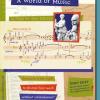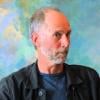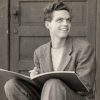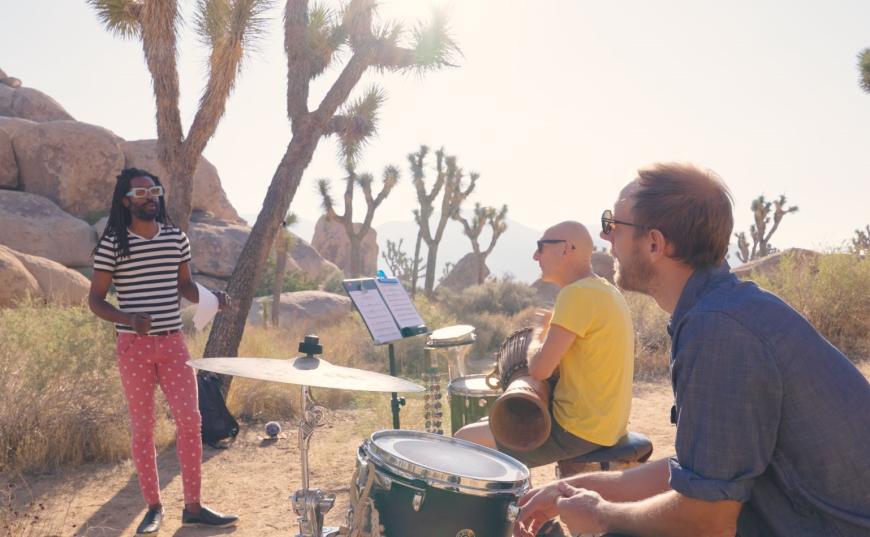
In a fascinating variety of genres and forms, music has served Eva Soltes, as she has served music, starting with growing up in a musical performing family around Hollywood in the 1950s and ’60s and extending to her personal assistance to visionary composer Lou Harrison in his final years. After Harrison’s death in 2003, Soltes assumed directorship of Harrison House, constructed from straw bales on the edge of Joshua Tree National Park, in the high desert east of Los Angeles. The building was designed in accordance with the ratios of just intonation, which the composer had applied to his compositions and instrumentation.
After a long time in the Bay Area studying classical Indian dance and directing concerts of period and avant-garde music at 1750 Arch Street in Berkeley, Soltes relocated nearby Harrison House and established a music and arts residency program, adding a center for permaculture several years later. Harrison chose the Joshua Tree site in part to further his physical and spiritual well-being. “Living with nature in the desert and seeing first-hand the effect of climate change, I began to say, ‘Without the Earth, there is no art,’” Soltes reflects in a phone interview.

But it took a visit from Portland, Oregon-based composer Kennedy Verrett, in the midst of COVID’s first year, to open Soltes’s ears more fully to the soundscape of her adopted home. “He said, ‘Let’s go for a walk,’” she recalls. “So off we went on that windy Sunday along this valley I’d been walking for 20 years. And Kennedy starts showing me how the wind is creating polyrhythms with the plants.” Verrett, who’s African American and had marshaled a drum corps for Portland’s Black Lives Matter demonstrations earlier in the year, compared the natural polyrhythms to those in African traditional music.
“He pointed out that every plant reacts differently to the wind,” Soltes continues. And I went, ‘Oh my god, you’re right!’ I never saw it that way, as music. Then he would pick up little tiny stones, and he’d find the key and resonance of a certain rock. But he would put everything exactly back down where he’d found it. Absolutely mindful, respectful. And he’d show me how he could create melody from the shape of rocks, looking at how they go up and down. It’s spatial, and he translates that into musical scales. Three quarters of the way through this walk, I looked at him and said, ‘We’re listening to the landscape, and I’ve never had an experience like this! We should do a piece in the park for a walkthrough audience and bring this reality to more people.’”
The result will premiere on the weekend of Earth Day, under the title SoundCheckEarth, staged outdoors at Cap Rock, a promontory in the center of Joshua Tree National Park with a wheelchair-accessible half-mile walking loop and a parking lot. The spot is already associated with musical legend: It’s where country rock legend Gram Parsons, another fan of the desert, was cremated in 1973.
Like Soltes, Verrett picked up some Hollywood cred, but rather later in life. He’d majored in atmospheric science at the University of Louisiana Monroe, not far from his hometown, but was also attracted to scoring music for films. Throughout public school and college, he attended and made music at Southern Baptist churches.
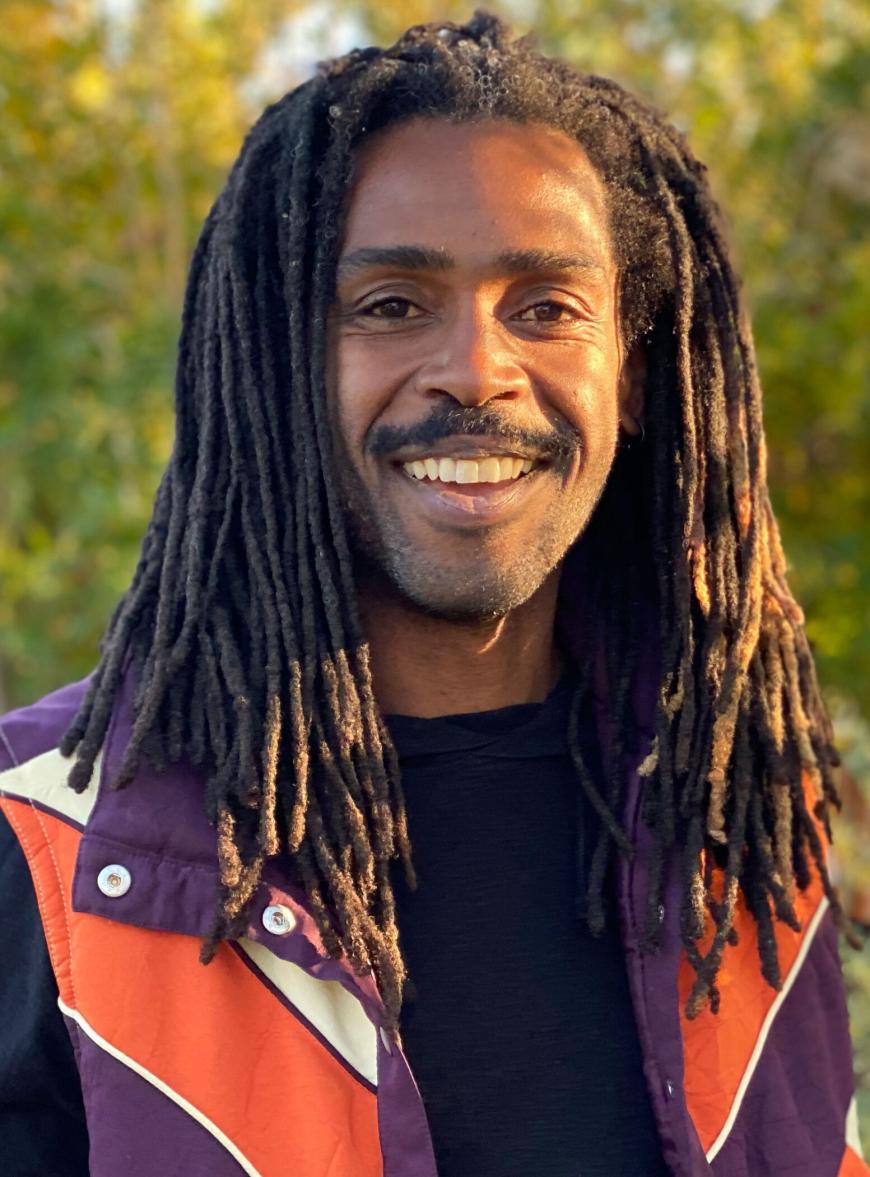
Over lunch a few steps from his Portland studio, Verrett, now 42, recalls a seminal workshop in film scoring he attended while still at ULM, hosted by Disney composer Buddy Baker in New York City. “At the end of the second week, Buddy leans up to me and says, ‘If you really want to do film scoring — and you got a great feel for the dramatic cues — you got to get to the West Coast.’” Verrett got accepted at Cal State Fullerton, where composition teacher Lloyd Rodgers first introduced him to the music of Lou Harrison.
“When I first discovered I was into composing [at ULM], I’d listened to Bach, Mozart, Beethoven, Rossini, and followed along with the scores,” Verrett recounts. “But at the same time, I was interested in music from Africa, the intricacy of the polyrhythms. So in my grad studies, I was looking for living or recently living composers who were incorporating all these elements. I listened to a lot of the music from the Polish School, but that was really abrasive and lacking what I feel is necessary, which is heart. [In Harrison’s music] there was authenticity, and his compositional vocabulary, working with just intonation and pentatonic scales, was something I was already interested in. And he and I were really into world music.” Hearing that Harrison was gay gave Verrett yet one more thing in common with the older composer.
After Fullerton, Verrett enrolled at the USC Thornton School of Music, earning a graduate certificate in scoring for film and TV. One of his USC teachers, Christopher Young, then gave him a choice job “working seven days a week, doing all the stuff — orchestration, transcription, conducting — mostly with horror and superhero films. I learned that how you make a film scary is the music, but also the silence where you insert it. What was also cool was that Chris was experimenting with different sounds, and I was into the same thing.
“So I did the film-scoring situation every day for five years, doing 10 years’ worth of work. Then, I knew there had to be a better way. The limitations were the politics you play while you’re running around Hollywood and L.A. I’m not one of those persons who’s willing to step on somebody’s neck to get there. And for me the tradeoff was, do I want a fat bank account and no time to enjoy it, or do I want to write music that I find is meaningful and also be able to enjoy myself. So I quit working at Christopher Young’s one day and said, ‘I’m going to find my own voice.’”
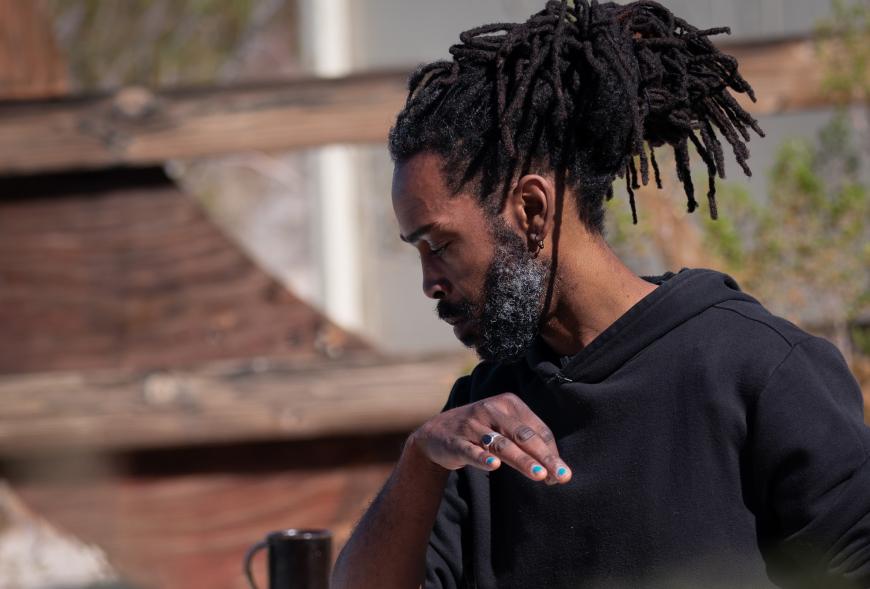
For a while, Verrett traded and sold vintage furniture, in the process learning how to rebuild things and retrofit old musical instruments, as well as make his own, a craft perfected by Lou Harrison and his longtime life partner Bill Colvig. “Then I would go out, I lived in Long Beach, and just play in nature, for the people right there,” says Verrett, “and all the outside sounds were incorporated. I created the Mad Composer Lab, and I was doing independent films with small budgets. As with creative people like Lou and Harry Partch, it was ‘What do I have in my kitchen that I can use on this score?’”
Next came a teaching job at the Encore High School for the Arts in Hesperia, north of San Bernardino. “I met some of the grooviest humans I’ve ever met, just rocking and rolling in the desert, and I got to experiment with some of my ideas about sound and timbre and rhythm. I’d take some of my classes, and we’d go collect old junk from the desert, then take it back and make music from it.”
After scouting out some land near Joshua Tree (but not yet knowing about Harrison House), Verrett and his then-partner moved north to Portland in 2018. “It was a little more laidback than Southern California, and nature is available in any direction. But it was largely a classical [music] scene, and I was writing all these experimental pieces, as part of the Mad Composer Lab, and teaching piano. I also worked for a cannabis agency, trimming and processing plants. I started building a community around the Lab, and between 2018 and 2020, I solidified how I wanted to be presented and curated.”
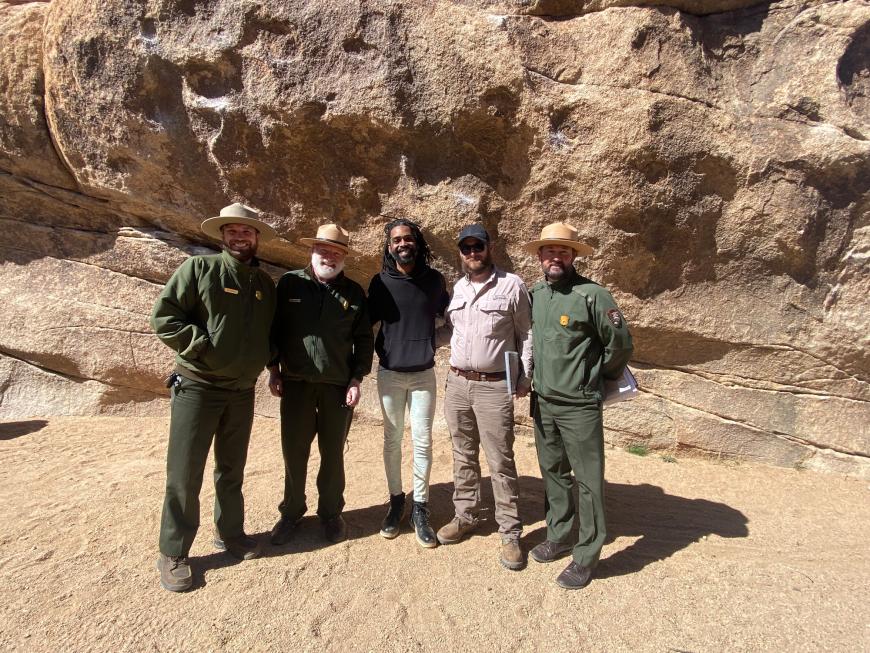
When COVID hit, Verrett “really plunged into composition” and was advised by his partner to start a GoFundMe to bolster his chances at acquiring property at Joshua Tree for a “sound-research facility where people could come.” He didn’t get the land, but his GoFundMe ended up catching the attention of Soltes through a fourth-hand referral. She’d been frustrated in seeking a Black composer for a residency at Harrison House until she heard about Verrett and was immediately impressed by his having named Harrison as one of his role models, alongside Pauline Oliveros (whom he’d workshopped with at Fullerton) and Julius Eastman.
“The next day we got on FaceTime, and it was as if we’d been friends forever,” says Soltes. “He was head of a drum corps, and Lou’s work was most notable as a percussionist, and he was using that drum music as an outcry, which is also so ‘Lou.’ People of color had been important to Lou, who left a portion of his royalties to help mixed-race gay couples.” Sight unseen, Soltes offered Verrett a residency at Harrison House longer than any preceding it. “John Luther Adams was here for three weeks, and the most anyone had ever spent was a month,” she points out, “but Kennedy seemed like a perfect match.”
Verrett came down to Joshua Tree with his then-partner and was entranced with Harrison House. “You walk in, and you feel all the love and creativity,” he testifies. “This was the height of the Black Lives Matter movement, so for me it was, ‘How can we get out of the madness and anger, and how do we heal?’ A lot of people don’t know that being Black and also gay, there’s lots of things you have to overcome. And these are things that were important to Lou Harrison as well, and that’s not very well known.”
The visiting couple joined Soltes in a meeting with the park’s superintendent, David Smith, and Smith’s husband. All parties were enthused about Verrett’s plans for SoundCheckEarth, and the composer’s initial two-month residency was followed by a composing fellowship at Harrison House and a residency with the park, working with park employees. Soltes, who’d produced and directed films about Harrison and others, documented Verrett’s developmental process on a yet-to-be-completed film, which will include footage from the SoundCheckEarth premiere. Here’s a segment, captured during Verrett’s earlier residency:
In September 2021, a panoply of instruments were brought to the Cap Rock site for an assessment of how their sounds sustained in an outdoor setting. The number of instrumentalists was set at 17 — strings, horns, woodwinds, and percussion — recruited from among Verrett’s Hollywood connections, as well as locally. “The Morongo Basin [adjacent to Joshua Tree] has a number of very, very good musicians and a pretty active arts community,” Soltes points out. The Californians will be joined by a didgeridoo player from Canada.
“The musicians will be migratory creatures, coming in,” says Verrett, “and they’ll all be hidden in spaces approved by the park, though there might be a couple in visible spaces.” Permitting from the park and other agencies required the attention of biologists and archeologists; the area had long been occupied or traversed by several Native American tribes.
“Joshua Tree involves three essential sounds that make up a soundscape,” notes Verrett, who uses the terms of “soundscape ecology” developed by Sonoma-based recordist Bernie Krause. “There are anthrophonic sounds, biophonic sounds, and geophonic sounds, and [in SoundCheckEarth] the sounds will come from all these sources. There are melodic contours in the shape of the mountains around the site, and I use them. And during the day, [the shapes] might make for different timbres; sunset and sunrise are different colors from midday.” Performances, each less than an hour, are set for 6 a.m., 10 a.m., and 11:30 a.m. on Earth Day, Friday, April 22, and for 2:30 p.m., 4:00 p.m., and 6:06 p.m. on Saturday, April 23.
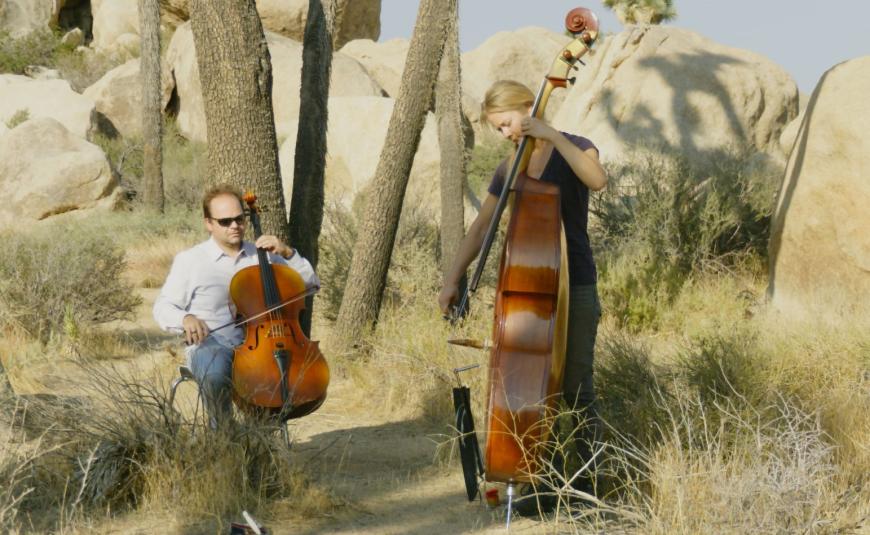
As COVID concerns abate, Soltes will be reactivating events at Harrison House involving music, crafts, and culture, as well as ecology. Along with her documentary account of SoundCheckEarth, she’ll complete a film about experimentalist composer Conlon Nancarrow, whom she’d served as personal assistant. She assumes that John Luther Adams might want to return to realize one of his own soundscapes. Verrett plans to take audiovisual equipment out to the waterfalls along the Columbia River Gorge, east of Portland, where he’ll create on-the-spot improvisations. “It’s part of the future of where we should be with music, especially post-COVID,” he states. “We should use the sounds and structures available to us, and they don’t always have to be indoors.”
Admission to SoundCheckEarth is free to the public, with parking or bus transportation provided on a first-come, first-served basis. Some accommodations are available at the Retreat Center and at nearby hotels.


